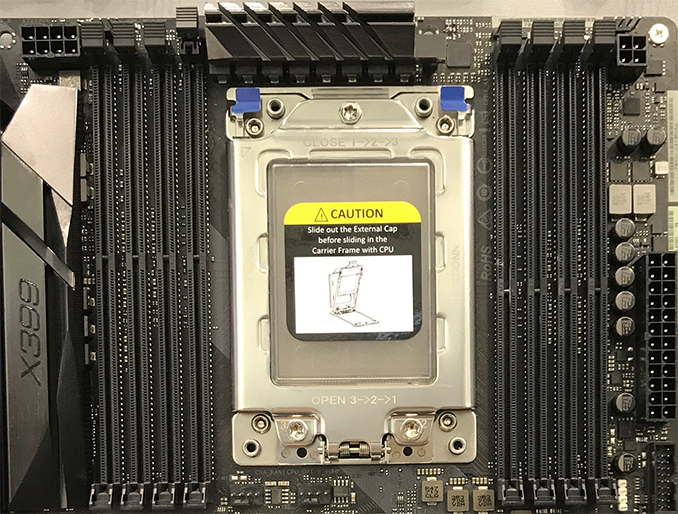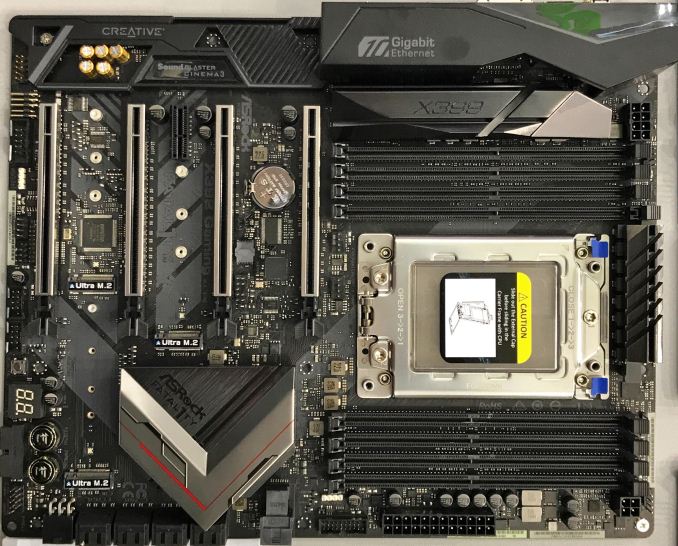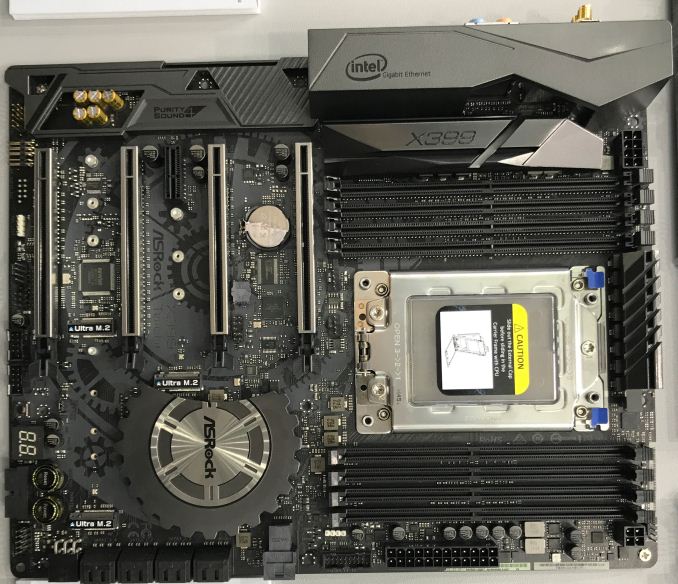ASRock Demos X399 ‘ThreadRipper’ Motherboards: M.2, U.2, 10 GbE, & More
by Anton Shilov on June 7, 2017 10:00 AM EST- Posted in
- Motherboards
- AMD
- ASRock
- Trade Shows
- Ryzen
- Computex 2017
- ThreadRipper
- X399

At Computex last week, ASRock demonstrated two motherboards designed for AMD’s upcoming ThreadRipper HEDT processors. The new platforms are for high-end workstations and designed to support up to four graphics cards though the 60 PCIe lanes from the CPU, over a dozen of storage devices and up to eight DIMMs. To a large degree, ASRock’s motherboards reflect overall positioning of the AMD X399 “ThreadRipper” platform as a premium high-end desktop play, and what to generally expect from makers of mainboards here.
ASRock plans to offer two motherboards for AMD’s ThreadRipper CPUs: the X399 Professional Gaming and the X399 Taichi. The mainboards are based on the same PCB (and the same AMD X399 chipset/socket), but have a slightly different feature set. The ThreadRipper motherboards that ASRock demonstrated at Computex featured an eight-phase digital CPU VRM, which is the feasible limit given the physical space available, but we have no idea the capabilities of the power delivery as of yet. ThreadRipper is meant to be a high performance, high power processor, so undoubtedly the motherboard vendors have built their boards to match. When it comes to the socket itself, it has 4094 pins and is very large (not surprising given its origin). We've seen the socket referred to as SP3r2 and TR4, although the official word from AMD is that it is the 'X399 platform'.
It will be interesting to see whether any motherboard maker manages to design a Mini-ITX mainboard for the ThreadRipper, but we will see. As we understand it, one of the problems with the socket, apart from the dimensions, is its cost to manufacturers that is prohibitively high at this time.
Both of the X399 motherboards from ASRock have eight DDR4 memory slots, but the manufacturer does not disclose speeds, ECC support and other details (although given previous discussions, we expect at least ECC and DDR4-2400). In fact, it does not even reveal the maximum amount of memory supported by the CPU. Though even if the company does know, it's almost certain that AMD wants to hold all of these cards close to their chest for future product announcements.
The X399 Professional Gaming physically has four PCIe 3.0 x16 slots (electrically set at two x16 and two x8) that can support up to four-way AMD CrossFireX or NVIDIA SLI multi-GPU configurations, as well as PCIe SSDs. In addition, there is a PCIe 3.0 x1 slot. As for storage options, ASRock has most configurations covered: the motherboard carries eight SATA ports, a U.2 connector, as well as three M.2 slots. To ensure that there is enough power for the latter, there is a 6-pin PCIe power connector right near the SATA ports. As for network connectivity, the motherboard features a 10 GbE port using Aquantia's AQC solution, two GbE headers (enabled by Intel controllers), as well as a 2x2 802.11 Wi-Fi module with Bluetooth. As for USB, there are 10 USB 3.0 ports in addition to two USB 3.1 ports (Type-A and Type-C) on the back panel. Finally, the X399 Professional Gaming has a 7.1 audio sub-system enhanced using Creative Labs’ SoundBlaster software.
| ASRock's X399 Professional Gaming and X399 Taichi for AMD ThreadRipper CPUs | |||
| X399 Professional Gaming | X399 Taichi | ||
| CPU Support | AMD ThreadRipper CPUs in LGA4094 form-factor | ||
| Graphics |
4 × PCIe 3.0 x16 (2 × x16, 2 × x8) |
||
| Chipset | AMD X399 | ||
| Memory | Eight DDR4 DIMM slots | ||
| Ethernet | 1 × 10 GbE Aquantia AQtion AQC107 2 × Intel GbE controllers |
2 × Intel GbE controllers | |
| Storage | 8 × SATA 6 Gbps 3 × M.2 (PCIe 3.0 x4 or SATA) 1 × U.2 (PCIe 3.0 x4) |
||
| Audio | Realtek ALC1220 (?) 7.1 channel audio with Creative Labs SoundBlaster Cinema 3 enhancements |
Realtek ALC1220 (?) 7.1 channel audio with ASRock Purity Sound 4 |
|
| USB | 8 × USB 3.0 Type-A 1 × USB 3.1 (Gen 2) Type-A 1 × USB 3.1 (Gen 2) Type-C |
||
| Other I/O | Dual band 802.11ac Wi-Fi + Bluetooth 4.x, PS/2 | ||
| Form-Factor | ATX | ||
| MSRP | Expensive | Less Expensive | |
It is worth nothing that we expect the X399 chipset to be as capable as the AM4 X370 platform, which means that some of the features on the motherboard are likely to have shared resources, meaning having one enabled will disable some others. AMD has engineered the CPU to have 60 PCIe lanes for storage and graphics, which will nominally mean most configurations will allow three GPUs (totalling 48 lanes) and three M.2 slots (totalling 12 lanes) although the 10GbE controller will require some lanes as well as the other Ethernet and perhaps a USB port controller or two. Until we see the chipset diagram, it will be hard to tell at this point.
The ASRock X399 Professional Gaming and the X399 Taichi will be available later this year when AMD releases its ThreadRipper CPUs. It goes without saying that the motherboards are not going to be cheap: they are not designed for general consumers and their server origin will have a direct impact on pricing.
Related Reading:
- AMD CPU Updates: 16 Core ThreadRipper w/64 PCIe Lanes This Summer, Epyc Launching June 20th
- AMD Announces Ryzen AGESA 1.0.0.6 Update: Enables Memory Clocks Up To DDR4-4000
- Computex 2017: AMD Press Event Live Blog
- ASRock Announces X299 Professional Gaming i9 with 3-Way Multi-GPU, 10Gb Ethernet, & Wi-Fi
- Intel Announces Skylake-X: Bringing 18-Core HCC Silicon to Consumers for $1999
- Intel Announces Basin Falls: The New High-End Desktop Platform and X299 Chipset
Source: ASRock












69 Comments
View All Comments
SaturnusDK - Thursday, June 8, 2017 - link
You have obviously got no idea how expensive it is to have exactly twice as many high speed interconnects routed on a motherboard the exact same size. As the number of interconnects increase the difficulty in routing and shielding these individually grows exponentially. Remember there still has to voltage regulators room for connectors with a specific spacing, 3x m.2 and 1x u.2 slot directly on the board etc etc. Pretty sure the board is at least 8-layer if not 12. That is excessively expensive to manufacture.DanNeely - Wednesday, June 7, 2017 - link
The rumor mill says starting at $849 for the 16/32 variants.http://wccftech.com/amd-ryzen-threadripper-16-core...
Gothmoth - Wednesday, June 7, 2017 - link
that would be fantastic but i doubt it .. there is not much room for 12 and 14 cores than.and if the perfoemance is right AMD has no reason to sell it THAT cheap.
close - Wednesday, June 7, 2017 - link
Well one chip apparently costs AMD ~$120 so it's still very profitable. This will also give you an idea of the premium Intel squeezed from customers over the years.nevcairiel - Wednesday, June 7, 2017 - link
These numbers rarely include R&D budget, so its hard to really put a price on a CPU that reflects the true cost, not only the production but also all the money that went into development.Topweasel - Wednesday, June 7, 2017 - link
R&D budget is going to be mostly across the whole Ryzen large since this, the Ryzen's, EPYC, are all using the same die. So this would be more about development of the packaging. This isn't HCC where you have a +20C die that only has low volume markets. That increases the amount that Intel has to increase cost to recoup funding.But still I think people look at Intel's pricing and see them as the best supply to demand scenario. It's not Intel has been cushioning costs due to lack of competition. How someone can look at 500% profit and talk about R&D costs is beyond me. If it takes 1000% profit to be profitable then neither company would be in this market.
systemBuilder - Thursday, June 8, 2017 - link
I think you forget that when the i486 was released it cost $25 to fabricate and sold for $400. That is more profitable than printing dollar bills. 1600% markup!close - Thursday, June 8, 2017 - link
Then I call it a massive coincidence that Intel decided to sell you high end HCC CPUs at "dirt cheap" prices (for Intel and compared to the Xeon prices - since this is what they are) exactly when AMD managed to come up with something really competitive. Intel must be subsidizing the price out of their own pockets, right?This was exactly a competition issue. No competition in almost any CPU segment meant Intel could slowly increase prices since they would sell anyway in one segment or another. As soon as competition appeared prices dropped. It's literally a textbook example.
prisonerX - Wednesday, June 7, 2017 - link
Since demand is elastic with respect to price, you don't maximise your revenue just by charging more. Depending on the market you may make more money by reducing the price, since you'll sell more.Development costs are fixed and therefore irrelevant to pricing, that money is already spent. It may be relevant to the company's survival if you spent too much though.
Timoo - Wednesday, June 21, 2017 - link
Unless & until you are in a semi-monopoly position. Then it doesn't matter any more; people NEED CPU's, no matter the price. And Intel díd exactly that: bringing a Gxx Pentium chip for 60$, to reap up the bottom lines of profits as well. They did not háve to lower their prices; demand in a monopoly situation is more constant than in a more open market.